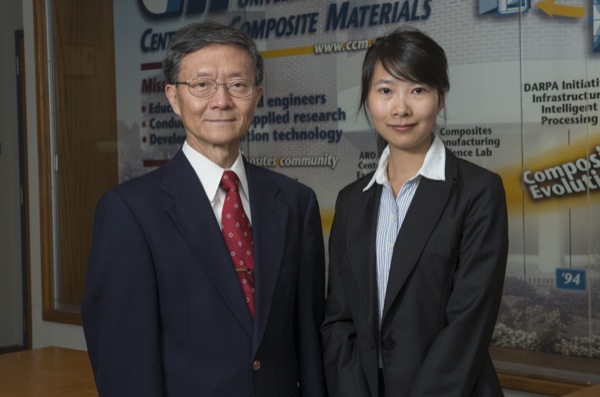Jan 23 2013
Faculty and students in the University of Delaware’s College of Engineering continue to blaze a trail of innovation, reporting recent research milestones in flexible composites and fuel cells.
 Tsu-Wei Chou (left) and Mei Zu
Tsu-Wei Chou (left) and Mei Zu
The Chou research group recently reported success in fabricating flexible composites based on carbon nanotube (CNT) fibers in the high impact factor journal, Advanced Functional Materials (AFM). A micrograph image illustrating the pattern of a buckled CNT fiber in the stretchable conductor was selected as the journal’s cover photo for the January 2013 issue.
Both light and strong, carbon nanotubes (CNTs) are known as a revolutionary material with excellent mechanical, electrical and thermal properties. Continuous CNT fibers are one-dimensional assemblies of CNTs that show potential to retain the superb properties of individual CNTs on a macroscopic scale. They belong to a new class of nano-structured materials with potential applications in electronics, sensing and conducting wires.
Motivated by their high electrical conductivity and ability to kink without cracking, Tsu-Wei Chou, Pierre S. du Pont Chair of Engineering, and his research team used CNT fibers to fabricate a stretchable conductor. The result was a CNT fiber/PDMS flexible composite that can be subjected to repeated stretching-and-releasing cycles up to a prestrain level of 40 percent with little variation in electrical resistance.
According to the paper’s lead author Mei Zu, a visiting student from Tongji University in Shanghai, China, these findings demonstrate the potential of these flexible CNT fibers to be used as reinforcements for ultra-light weight multifunctional composites.
Under Chou’s guidance, Zu spent two years exploring the electrical and mechanical behavior of CNT-based fibers and composites as a doctoral student in UD’s Department of Mechanical Engineering and at the Center for Composite Materials.
This research was supported in part by the U.S. Air Force Office of Scientific Research and the National Research Foundation of Korea through the Global Research Laboratory program.